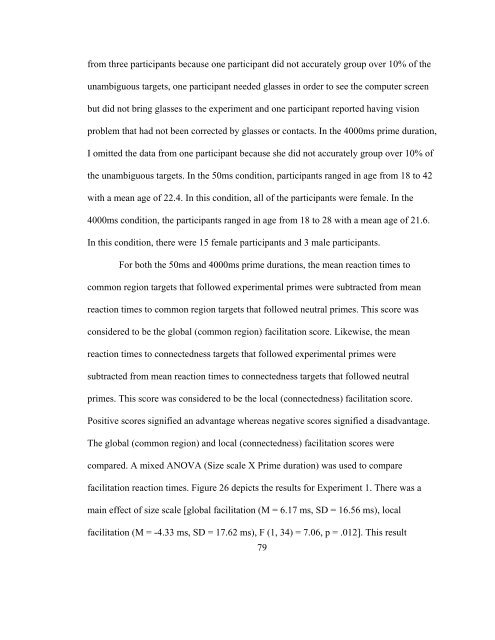The Use of Iambic Pentameter in the
The Use of Iambic Pentameter in the
The Use of Iambic Pentameter in the
You also want an ePaper? Increase the reach of your titles
YUMPU automatically turns print PDFs into web optimized ePapers that Google loves.
from three participants because one participant did not accurately group over 10% <strong>of</strong> <strong>the</strong><br />
unambiguous targets, one participant needed glasses <strong>in</strong> order to see <strong>the</strong> computer screen<br />
but did not br<strong>in</strong>g glasses to <strong>the</strong> experiment and one participant reported hav<strong>in</strong>g vision<br />
problem that had not been corrected by glasses or contacts. In <strong>the</strong> 4000ms prime duration,<br />
I omitted <strong>the</strong> data from one participant because she did not accurately group over 10% <strong>of</strong><br />
<strong>the</strong> unambiguous targets. In <strong>the</strong> 50ms condition, participants ranged <strong>in</strong> age from 18 to 42<br />
with a mean age <strong>of</strong> 22.4. In this condition, all <strong>of</strong> <strong>the</strong> participants were female. In <strong>the</strong><br />
4000ms condition, <strong>the</strong> participants ranged <strong>in</strong> age from 18 to 28 with a mean age <strong>of</strong> 21.6.<br />
In this condition, <strong>the</strong>re were 15 female participants and 3 male participants.<br />
For both <strong>the</strong> 50ms and 4000ms prime durations, <strong>the</strong> mean reaction times to<br />
common region targets that followed experimental primes were subtracted from mean<br />
reaction times to common region targets that followed neutral primes. This score was<br />
considered to be <strong>the</strong> global (common region) facilitation score. Likewise, <strong>the</strong> mean<br />
reaction times to connectedness targets that followed experimental primes were<br />
subtracted from mean reaction times to connectedness targets that followed neutral<br />
primes. This score was considered to be <strong>the</strong> local (connectedness) facilitation score.<br />
Positive scores signified an advantage whereas negative scores signified a disadvantage.<br />
<strong>The</strong> global (common region) and local (connectedness) facilitation scores were<br />
compared. A mixed ANOVA (Size scale X Prime duration) was used to compare<br />
facilitation reaction times. Figure 26 depicts <strong>the</strong> results for Experiment 1. <strong>The</strong>re was a<br />
ma<strong>in</strong> effect <strong>of</strong> size scale [global facilitation (M = 6.17 ms, SD = 16.56 ms), local<br />
facilitation (M = -4.33 ms, SD = 17.62 ms), F (1, 34) = 7.06, p = .012]. This result<br />
79

















